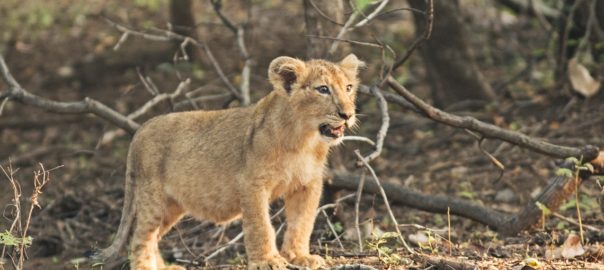The Asiatic Lion census of 2020 in Gujarat’s Gir National Park, the last bastion of this lion species in the world, was replaced by ‘Poonam Avalokan’ or full moon night observation due to Covid-19 pandemic and the lockdown.
Carried out on June 5 and June 6 the observation found 674 lions now in Gujarat which is a rise of 151 lions from the count of 523 estimated in May 2015. In a press statement and tweet by Prime Minister Narendra Modi and Environment Minister Prakash Javadekar, it was announced that India recorded a 29% increase of the lion population in the last five years.
What is even more significant, given Gujarat’s insistence to keep the Asiatic Lions within its borders, is that the distribution range of the lions has increased to 30,000 sq. km, a rise of 36% as compared to 22,000 sq. km in 2015. Compared to 2001, the lion population has doubled and the area they inhabit has expanded by 400%.
This is great news. Since 1968 when the first official lion population census was done in India, the numbers have steadily grown, all thanks to the relentless efforts of the forest officials and locals who have ensured that the Lion kings of India are continued to be given the same respect that the Nawab of Junagadh gave them decades ago by putting a ban on hunting and offering vast areas of Junagadh as safe haven to the then dying lions.
From a mere 20 to 600 plus lions in a single protected area in the world is indeed no small feat. However, some local wildlife experts think the number of lions in Gujarat could have now easily crossed the 1000 mark and are no more restricted to living in the protected areas alone.
Then why are the official record showing 674? There could be a number of reasons.
Aged counting methods
The lion population estimation in Gujarat is done by an age-old method called Direct Beat Verification or Block Count Method. Officials lay stake at watering holes distributed across the lion terrain and monitor the wild cat movements. Whenever a lion comes to the watering hole within a 24-hour period, its movement is recorded for the census. This exercise involves the Gujarat forest department officials, local experts, researchers, and volunteers, totaling around 1400-2000 individuals for a typical two to three days census.
Yadavendra Jhala, the senior scientist at Wildlife Institute of India (WII) who led the tiger survey in India, says this 100-year-old method for counting lions might not be giving accurate estimates. What the method does not use is,
-Camera trapping, used frequently nowadays to get non-intrusive data and images of animals like tigers.
-Identifying lions based on permanent marks
-Statistical estimates based on predatory patterns
-Number of prey base
Jhala has been trying for 15 years to convince the Gujarat government and the forest authorities to allow his team of scientists to conduct the census more scientifically but has been consistently refused.
Before the latest census too, WII had been wanting to set up 10,000 camera traps across the Lion landscape but the proposal was rejected a month before the census. The reason given was that unlike tigers, lions could not be traced accurately using markings and camera traps would not be useful.
Also Read: Gujarat says No to Camera Traps to Count Asiatic Lions
Jhala says, “With the current methods and the fact that the lions can range as much as 700 sq. km, you can both grossly undercount and overcount.”

Beyond the boundaries
An official familiar with the Gir lions says that there are more chances that the 674 number is an under count.
“There are lions outside the protected area,” he says. “A higher number could mean Gujarat may have to send some lions to neighbouring Madhya Pradesh.”
In April 2013, the Supreme Court asked the Union government to translocate some lions to Kuno. It said, while hearing a petition, the Asiatic lions existed in a single sub-population and were vulnerable to extinction from unpredictable events, such as an epidemic, a large forest fire, etc
However, this order has not been followed through by the Gujarat state government citing various reasons from lack of good habitat in Madhya Pradesh to other legal clauses that increase paperwork and reduce the chances of any lions moving out of the state to another location.
Also Read: More Asiatic Lions Dead. Toll Rises to 21 in Gir
Meanwhile, in 2018, the real scare came in the form of the Canine Distemper Virus outbreak in Gir National Park which led to the death of 36 lions. While vaccines brought down by the USA checked the deaths at the time, some believe that the lions are still vulnerable to CDV as well as other infections such as Babesiosis (tick infection) that recently killed 20 more lions in the protected area.
Poonam Avalokan
The third reason that the current lion population estimate could be wrong is the method used this time. Poonam Avalokan is a monthly in-house exercise carried out on Full-moon night. Field staff officers spend 24 hours assessing the number of lions and their locations in their respective jurisdictions. This method was started in 2015 a month before the national census to prepare for the main study.
On June 5 and 6 the limited number of forest staff left within the park and tested duly for coronavirus covered 10 districts and 13 forest divisions. The teams kept moving in their zones as compared to the beat method where teams stay put at one location near water holes. While the method is acceptable, it does leave doubts of a lion being counted doubly or being left out entirely.
The Asiatic lion population in Gir has gone up as has the area where they inhabit. With all the cheer that comes with the news is also the question of how long will the state of Gujarat resist the increasing demands of conservationists and scientists to allow a second habitat and population in another part of the country. If conservation of a unique species remains the primary motive, the decision of how its future can remain safe, should not be difficult to make.
Also Read: The 9 Core Issues Affecting the Safety of Asiatic Lions in India





